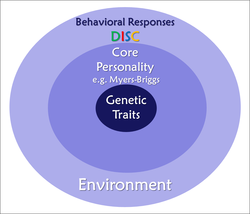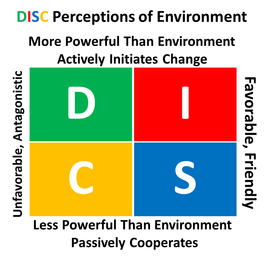Understanding DISC Personality Test – DISC Profile Model of Behavior
While the theory behind the DISC Profile has been around since the ancient Greeks, the current understanding reflects the work of William Marston in The Emotions of Normal People (1928). Many other psychologists have built on Marston’s foundation to create the modern versions of the DISC Personality Test. Here is a brief 8-point explanation.
1. BEHAVIORAL RESPONSES TO ENVIRONMENT

While DISC Assessment is often referred to as a personality test, it actually concentrates on one aspect of the personality – external behaviors. Consider the diagram to the left. At the center are GENETIC TRAITS over which we have no control. Coming out from the center is CORE PERSONALITY, the complex set of factors that make us who we are. The most popular measure of core personality is Myers-Briggs Type Indicator (MBTI). At the outer edge is BEHAVIORAL RESPONSES, the way a person acts in his or her environment. These behaviors are the focus of DISC Test. DISC measures predictable patterns in one’s behaviors. Also, since it considers the environment, it is possible that one’s DISC results will be different in one setting over another.
2. PERCEPTIONS OF ENVIRONMENT

Some perceive themselves as more powerful than their environment and will seek to change the environment either through challenging dominance (D) or interactive influence (I). Others see themselves as less powerful than the environment and will make the best of it either through submissive steadiness (S) or conscientious attention to standards (C).
D types naturally see the status quo as unfavorable and will initiate major changes to create new conditions, as to where C types may critically evaluate the status quo but set out to improve or correct the flaws in what exists. D’s may break or replace the frame, and C’s try to improve the existing frame.
On the other hand, I’s are motivated to create better environments through winsome interaction, where S types simply adjust to the status quo through peaceful cooperation. I’s positively introduce new frames, while S’s graciously maintain the existing frame.
3. PRIORITIES
D and C types place priority on TASKS, while S and I types prioritize RELATIONSHIPS. This is not a matter of capability, as all can get things done and enjoy relationships. But each type has a “compass” that motivates them to prioritize one over the other.

4. PACE
D’s and I’s are FASTER-PACED and S’s and C’s are SLOWER-PACED. Again, anyone can go fast or slow, but each person has an engine that is geared to go in one speed most of the time.
5. STYLE
D’s and I’s are more OUTGOING and S’s and C’s are more RESERVED. In different situations, anyone can and will be either of these, but will prefer one most of the time.
6. TYPE
This is where all the factors converge and we apply D, I, S, C.
- D type: Dominant – task priority, fast pace, outgoing style to assert self even in an antagonistic or unfavorable environment.
- I type: Inspiring – relationship priority, fast pace, outgoing style to influence others, preferably in a favorable or friendly environment.
- S type: Supportive – relationship priority, slow pace, reserved style to peacefully cooperate, preferably in a favorable and friendly environment.
- C type: Conscientious – task priority, slow pace, reserved style to critically maintain high standards even in an unfavorable environment.
The DISC Assessment consists of 24 questions that determine where each person falls on the high/average/low scale for each of these types.
7. BEHAVIORAL BLEND
Most people are not just one of the DISC styles, but have a special BLEND OF INTENSITIES along the continuum of all four types. This makes each person unique.
8. FLEX
While each person has a natural type and blend, it often becomes necessary to FLEX or ADJUST our behaviors to relate to others or address situations more effectively.
To understand more about how the DISC Personality Test works to reveal one’s type, read the next article in the series, DISC Profile Most and Least Preferences.


